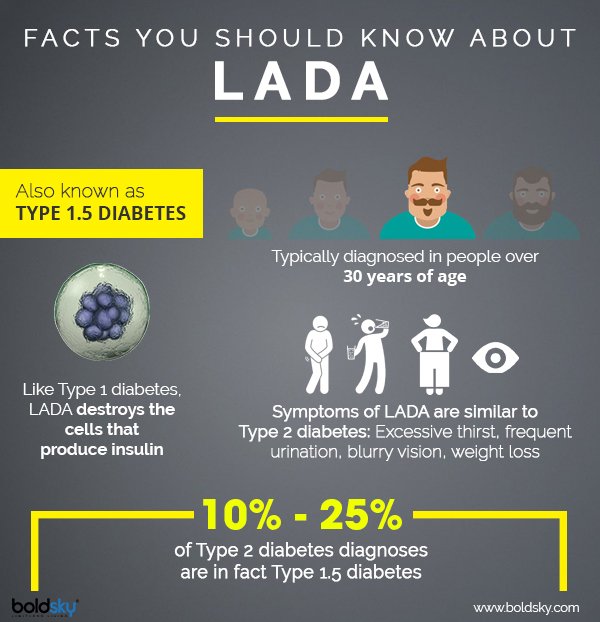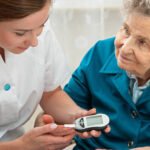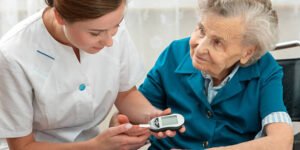
Diabetes Type 1.5 (LADA)
You may have heard of Type 1 diabetes and Type 2 diabetes, but did you know that there is also Type 1.5 diabetes? Its full name is latent autoimmune diabetes in adults (hereinafter referred to as LADA), and because it contains two different characteristics of type 1 diabetes and type 2 diabetes, it is also called type 1.5 diabetes. Let me introduce you to it below.
What is type 1.5 diabetes?
LADA is a form of type 1 diabetes. According to the definition of Professor David Leslie, Director of Action Research of the European Action LADA organization, LADA refers to patients aged 30 to 50 who are initially diagnosed with non-insulin-dependent diabetes and who have glutamic acid decarboxylase autoantibodies ( Or called glutamic acid decarboxylase autoantibody, Glutamic acid decarboxylase autoantibody, referred to as GAD-Ab).
Causes of Type 1.5 Diabetes
Because LADA is similar to type 1 diabetes, before we understand LADA, we must first know that in patients with type 1 diabetes, the beta cells responsible for secreting insulin in the patient’s pancreas are destroyed by the autoimmune system, resulting in insufficient insulin, which is called It is Insulin dependent diabetes mellitus (IDDM).
LADA is also a disease caused by autoimmune problems. It is also because beta cells are gradually attacked and damaged and cannot produce insulin normally. However, unlike type 1 diabetes, type 1 diabetes develops because beta cells are rapidly damaged. Most of the patients are in children and adolescents, while the β-cell damage in LADA patients develops relatively slowly, and the onset time is mostly in adulthood. Therefore, LADA may be misdiagnosed by doctors as type 2 diabetes, which also occurs in adults.
Type 1.5 diabetes misdiagnosis
It is actually very common for LADA to be misdiagnosed as type 2 diabetes. The UK’s Global Diabetes Community website (The global diabetes community) points out that about 15 to 20% of type 2 diabetes patients may actually be LADA. Because LADA patients have β-cell damage due to autoimmune problems and are less likely to have insulin resistance, drugs that reduce insulin resistance are not very effective in LADA patients.
How common is type 1.5 diabetes?
According to the UK Prospective Diabetes Study, LADA-specific antibodies are present in 6 to 10% of diabetes cases. An estimated 25% of people diagnosed with diabetes under the age of 35 are LADA patients.
| Type | Type 1 | Type 1.5 | Type 2 |
| Age of onset | Children and Teenages | 25-40 years old | Middle-aged and elderly |
| Autoimmune attack leads to the destruction of pancreatic β cells | Yes | Yes | No |
| Insulin resistance | No | Slight | Yes |
| Obese | Thin | Thin | Fat |
| Secretion of Insulin | Very Small Amount | Small Amount | Regular or Insufficient |
Symptoms of type 1.5 diabetes
Although it occurs in adulthood, unlike type 2 diabetes, patients with LADA are usually not obese or overweight, so it is impossible to judge whether they may have LADA from their appearance.
Early symptoms of LADA include:
- Feeling tired all the time or getting tired easily after meals
- Dizziness
- Feeling hungry soon after a meal
Over time, LADA patients’ ability to produce insulin will gradually decrease, and they may experience the following symptoms:
- Drink too much
- Polyuria
- Blurred vision
- nerve tingling
- Nerve paralysis (perhaps a sign of neuropathy)
Early detection of LADA is important because if LADA is diagnosed late in the disease, the risk of diabetes complications increases.
Early detection of LADA is important because if LADA is diagnosed late in the disease, the risk of diabetes complications increases.
Risk groups for type 1.5 diabetes
The most important gene affecting type 1 diabetes and LADA is the human leukocyte antigen (HLA) gene located on the sixth pair of chromosomes, and the age of onset is usually over 30 years old.
Diagnosis and treatment of type 1.5 diabetes

To diagnose LADA, three conditions must be met at the same time:
- Age:
It occurs more often in adults. The age of diagnosis ranges from 25 to 40 years old, and most EU countries currently adopt the 30-year-old age limit. - Autoantibodies:
There are autoantibodies related to diabetes. This is the difference between LADA and type 2 diabetes. Autoantibodies (ICA), glutamic acid decarboxylation autoantibodies, insulin autoantibodies (IAA) and casein autoantibodies. Tyrosine Phosphatase-like Insulinoma Antigen-2 autoantibody (IA-2A), etc. are common autoantibodies in diabetes related to autoimmune mechanisms. - Insulin dependence:
It takes a period of time after diabetes is diagnosed to progress to insulin dependence. This is the difference between LADA and type 1 diabetes, and it is currently believed that it will take at least 6 months.












